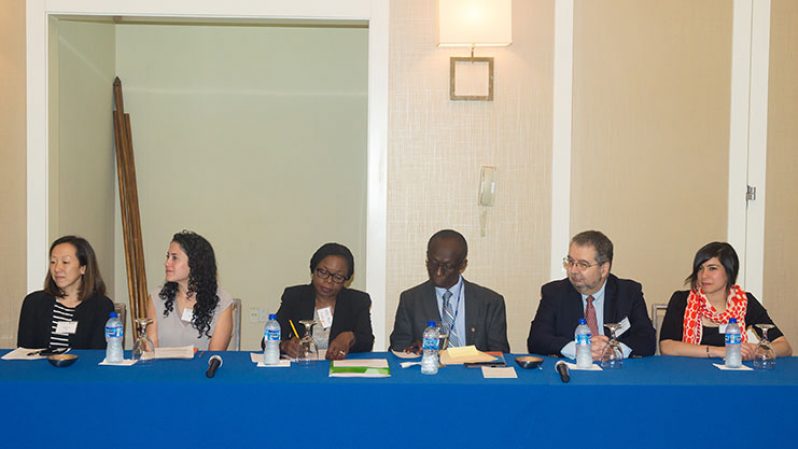…Health Ministry mulls seven-pill dosage
THE use of a triple therapy IDA (Ivermectin, Diethycarbamazine and Albendazole) from this year is mandatory if Guyana is to be successful in interrupting the transmission of Lymphatic Filariasis (LF), commonly called Filaria or ‘Big Foot’ by 2020, Deputy Chief Medical Officer (DCMO), Dr. Karen Boyle said.
“Our current use of DA (Diethycarbamazine and Albendazole) alone will need at least three more years to achieve elimination and therefore we would miss the target of 2020. We are therefore about to assess the acceptability of this modified (triple therapy) intervention, which will have a pill burden of seven to nine pills in a stat dose among the target population,” the DCMO explained.
The acceptability study is scheduled to be implemented in May, which will then inform the Social Mobilisation Campaign. According to her, with the implementation of IDA, Guyana would be well on track to eliminating ‘Big Foot’ by 2020.
Dr. Boyle made the supposition on Tuesday at the Guyana Marriott Hotel during the start of a three-day high-level Technical Cooperation Mission meeting organised by the Pan American Health Organisation/World Health Organisation (PAHO/WHO) in collaboration with the Ministry of Public Health.
The technical team is reviewing the progress of strategies, plan of action and current challenges for achieving the Elimination of Lymphatic Filariasis (ELF) in Guyana.
“At present, Guyana has 44 per cent geographical coverage having conducted the exercise in four (Regions Three, Four, Five and 10) of the nine endemic regions that surpassed the one per cent threshold in the 2001 mapping exercise. Moreover, in 2017 and 2018, Guyana achieved 86 per cent and 85 per cent epidemiological coverage respectfully, and as such, successfully marked two consecutive years with adequate coverage having surpassed the target of 65 per cent,” the DCMO explained as she gave a progress report.
In 2000, Guyana embraced WHO’s Global Programme for the Elimination of Lymphatic Filariasis by 2020, which entails a comprehensive strategy to stop the spread of the infection through large-scale annual Mass Drug Administration (MDA), and alleviate the suffering caused by the disease.
In 2001, a mapping among schoolchildren revealed that Guyana is endemic to Lymphatic Filariasis. The Mass Drug Administration (MDA) was identified as the best intervention to eliminate the disease.
“In 2003, Guyana started with the use of Diethyl Carbamazine (DEC) fortified salt; however, it proved difficult to confirm the epidemiological coverage. In 2008, Guyana started to implement in some geographical settings Mass Drug Administration using diethylcarbamazine and adlbendazole pills,” Dr. Boyle detailed.
Since then, the Public Health Ministry has had difficulties in successfully executing five consecutive MDAs as required for the elimination of the disease.
Guyana’s current strategy is tailored to target the population within schools and workplaces with support coverage at fixed points such as market places and religious institutions, the DCMO said.
With Guyana’s geographical coverage currently at 44 per cent, Dr. Boyle said key to scaling it up to 100 per cent is a remapping survey which is being conducted in the six regions (Regions One, Two, Six, Seven, Eight and Nine) that have not yet been apart the Mass Drug Administration. “This survey will give an updated picture as to which other implementation units need to be included in the current Mass Drug Administration excise,” the DCMO explained, even as she underscored the importance of utilising the triple therapy IDA at this stage to reach the 2020 deadline.
PAHO/WHO donated the Diethycarbamazine and Albendazole for the initial rounds of the MDA, and has committed to supply the country with additional drugs for the IDA if it is accepted on the ground.
PAHO/WHO Country Representative, Dr. William Adu-Krow maintains that consistent delivery and high coverage in each round of MDA are essential for Guyana. He said the triple therapy provides an opportunity for countries like Guyana and Haiti, who are lagging behind, to reach the target in a shorter period.
“In 2017, research results to determine the potential of alternative strategies, such as biannual MDA or a combination of triple MDA medicines, to shorten the time required to reach elimination targets have been published. The possibility for countries to reduce the number of MDA years needed to achieve filarial elimination from five to two years, is now a reality,” Dr. Adu-Krow told those present.
He said the last two countries to eliminate filaria in the Americas have a golden opportunity to complete the last MDA rounds in 2020, and start the validation process of the WHO to obtain certification of elimination by 2024.
Dr. Adu-Krow said PAHO/WHO is pleased to partner with Guyana in its quest to eliminate the spread of the disease in the country. PAHO/WHO has been providing technical support over the years.
The high-level team currently in Guyana will make recommendations at the highest strategic and technical levels for the implementation of cost-effective and evidence-based interventions for ELF as a public health problem in Guyana.
The mission, led by the PAHO/WHO Director of Communicable Diseases and Environment Department is meeting with officials of the Ministry of Public Health (MoPH) and other partner ministries to discuss the implementation of the triple-drug therapy, as the new Mass Drug Administration (MDA) strategy recommended by PAHO/WHO and endorsed by the Ministry of Public Health.
Interventions in the Global Programme to Eliminate Lymphatic Filariasis are estimated to have prevented or cured more than 97 million cases so far and avert more than US$100 billion in economic losses over the lifetime of those who have benefited, according to PAHO/WHO.













